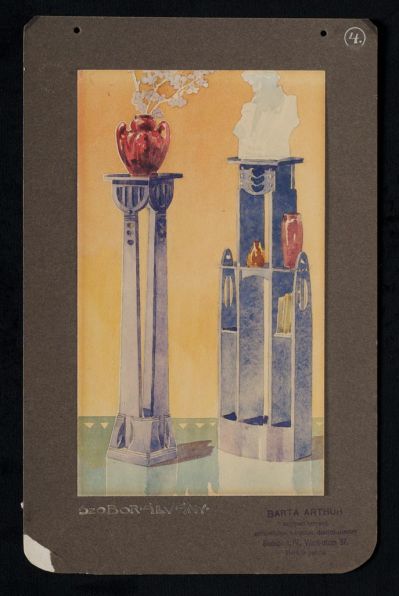
Furniture design - sculpture stands
| Accession Nr.: | KRTF 231.2 |
|---|---|
| Artist/Maker: |
Barta, Artúr (1875 - 1930 után) / designer |
| Date of production: |
(presumably)
|
| Place of production: | Budapest |
| Inscription: | BARTA ARTHÚR/ műipari tervező / műasztalos, kárpitos, díszítő-mester / Budapest, IV., Váczi-utcza 37. / Merkúr palota; BARTA ARTHÚR / MŰIPARI TERVEZŐ / KÁRPITOS / ÉS / DISZITŐ-MESTER |
|---|---|
| Materials: | paper |
| Techniques: | glued on cardboard; pencil; watercolour wash |
| Dimensions: |
height: 24 cm
width: 14 cm
|
Together with KRTF 232 and KRTF 235/1-2 these sketches were probably pages in a merchandise catalogue, as suggested by the inscription and shape of the stamps and the uniform holes for folding on the top part of the drawings. The colourful, picturesque furniture drawings seem to be elegant at first, but after looking at them for a longer time the lack of graphic professionalism is apparent at the more complicated junctures of the structures. This supports the hypothesis that these are not
pictures of real carpentry but sketches. Arthúr Barta participated first at the 1903 Christmas exhibition, with the historicizing furniture of an Empire lady's drawing room, as proven by the photo. On the other hand, the statue stands already show that their designer was familiar with both the British Applied Arts and the trends of Gödöllo. The geometrical structure, the pierced decoration as well as the reserved ornaments radiate the different, fashionable tendencies in contemporary decorative
arts, including the statue stands of Ede Wigand. This is also proved by the pattern collection (see MLT 2315-2321, 2519 and 4.424-5268) that was transferred by the Archives from the library of the Museum of Applied Arts. This pattern collection contained, among others, typical turn-of-the-century interior pictures cut from magazines, especially illustrations of English and Scottish works of art.
Literature
- Somogyi Zsolt: A magyar szecesszió bútorművészete. Corvina Kiadó, Budapest, 2009. - Nr. 85.
- Szerk.: Szilágyi András, Horányi Éva: Szecesszió. A 20. század hajnala. (Az európai iparművészet korszakai.). Iparművészeti Múzeum, Budapest, 1996. - Nr. 9.250. (Lichner Magda)

